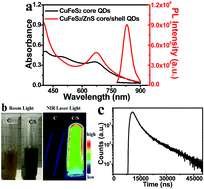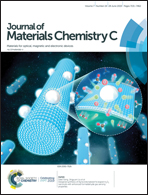Highly luminescent NIR-emitting CuFeS2/ZnS core/shell quantum dots for optical imaging of inflamed tissue†
Abstract
The cytotoxicities of the elements of current quantum dots (QDs) greatly restrict their applications in biomedical fields. Herein, we firstly proposed and synthesized oil-soluble heavier-element-free (or Cd-free) CuFeS2/ZnS QDs, and focused on the synthetic controls over the core/shell structure. It was found that although the as-prepared CuFeS2 QDs are nonemissive, the in situ ZnS-overcoating could make them exhibit bright near-infrared (NIR) photoluminescence (PL) (PL peak at 840 nm; PL quantum yield (QY) up to 52%). We also analyzed their shape, structure and elemental composition in detail. Next, by the interaction between oil-soluble QDs and liposomes, the aqueous QD-laden liposomes (named as LipQDs) were fabricated, allowing further exploration of bio-application. Finally, after further decorating with isolated macrophage membrane, the resulting LipQDs@M nanocomposites were observed to target actively postoperative tumor inflamed tissue (or other inflamed tissues), using an in vivo small animal IR optical imaging system. Our results indicate that these NIR-emitting CuFeS2/ZnS QDs should be a new promising fluorescent marker for biomedical optical imaging, as an alternative for Cd-, Hg-, and Pb-based ones.



 Please wait while we load your content...
Please wait while we load your content...